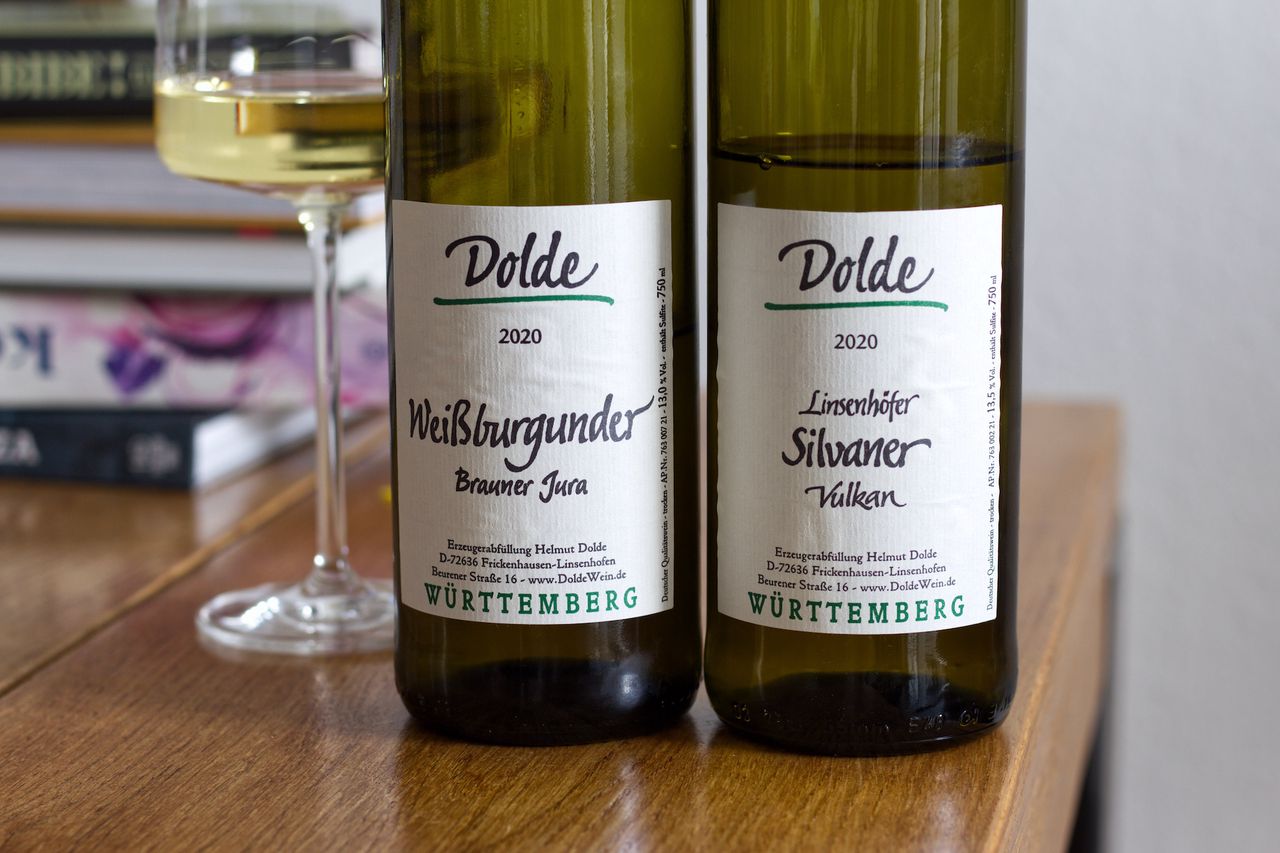Two Bottles Dolde
We drink brutally local from the winery Dolde a Silvaner Vulkan and a Weissburgunder Brauner Jura each from 2020.

I always find wine from the immediate vicinity exciting. This time, however, it feels a bit closer than usual. Hedwig and Helmut Dolde make wine in and around Linsenhofen and in the Neuffen Valley below Hohenneuffen Castle. The soil is special here: The vines stand on various Jurassic soils and in parts also soils of volcanic origin. This is rare in Germany and so more likely to be found in Burgundy. In addition to the soils, the altitude is remarkable. The vineyards directly on the edge of the Swabian Alb are sometimes over 520 meters above sea level, making them some of the highest in Germany. The climate is therefore cooler here than elsewhere, and what was more of a problem in the past could turn out to be a great advantage with climate change. Until a few years ago, Helmut Dolde was a full-time teacher and wine was a hobby. Therefore, there is no big cellar technology but manual work. The wines get attention, in the vineyard and in the cellar. And with this attention, he tries to bring out the differences in the sites and soils as clearly as possible. The fact that the wines are marketed and bottled by Helmut Dolde himself is also unusual, since most of the vineyards in the area are delivering their grapes to cooperatives. I haven’t measured, but as the crow flies, the distance from here to the vineyards may well be further than to Esslingen to Kusterer. Still, it feels even closer this time. When we sit on the balcony in the evening, or look through the skylight, the lights of Hohenneuffen Castle shine in the distance, and during the day, the vineyards below can also be glimpsed. It almost feels as if the grapes had grown in the front garden. A whole new feeling of regionality in the glass.
We start with the Weissburgunder. And this one starts with freshness in the glass. Still slightly yeasty, it’s still super young, with floral notes and bright fruit. The acidity is crisp, like green apple, lively and out the back of the tongue comes with much more spice than I would have expected. Air intensifies that even more. The acidity always remains crisp enough to counter, but the structure and spice become more and more. The Weissburgunder is juicy, fresh, easy to drink and still has depth.
This is also the case the next day. The play between acidity and the spice are great, the fruit is subtle, the freshness is awesome. I’m honestly a bit surprised at how well I like this right now. The wine quite casually takes a place among the best Weissburgunders under 10 euros that I have drunk so far. But there is not much time to think about that. Drinks just too nice. Sure, the last depth or particularly much complexity is missing, but who needs that with the great balance of fruit becoming more intense again towards the end of the evening and the structure.
The Silvaner starts more restrained. With only about 0.5 grams of residual sugar per liter, the wine is completely fermented, you could call it bone-dry. The nose is discreet, some pome fruit, definitely also freshness and very far back a small sip of bath water. Seems more closed and shows hardly anything straight on the tongue. Maybe a little gooseberry far back on the palate. But then it lingers with a bit of herbal spice for quite a long time. Normally air helps with something like this, but here it seems to go in the opposite direction today. The wine closes even more and especially compared to the amazing Weissburgunder, almost nothing happens in the nose at first. The mouthfeel, however, can convince. Nevertheless, the impression remains that it does not quite want to deliver today. Swirling helps a bit, but also does not bring forth the big change and so it heads back into the cooling.
That helped over night. It still feels slightly unsorted a day later with a light yeast impact, but there is already clearly more happening. The nose feels darker than the Weissburgunder and has more herbs, spices and power. The pome fruit remains, the bath water has completely disappeared. In the background you can guess a few bananas. Still far from a fruit bomb. On the tongue the wine has texture, coming much more from the feel than the taste. Although this is quite fun now the feeling remains that we are drinking far below its potential. Where the Weissburgunder is just already really great, the Silvaner should perhaps disappear for a few more months in the cellar or instead of breathing in the bottle rather end up in a carafe.
A residual that made it into the third day confirms this. The nose is still restrained, but there’s real action on the tongue now. Intense spice, apple fruit, apple stems and seeds, creaminess and a length I did not expect after the first two days. Yes, this is great Silvaner. How nice that we found wine like this right on our doorstep.